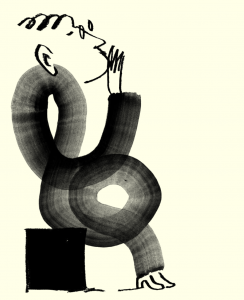Elliptical, celestial fiction by Sequoia Nagamatsu

“How High We Go in the Dark is a journey of hope and resilience in the aftermath of tragedy, as well as an exploration of the connective threads that tie us to each other and to our changing world. The novel kicks off in Siberia in 2030 where scientists have unearthed the 30,000 year old remains of a girl who may not be completely human. The following chapters follow a cast of intricately linked characters over generations and continents (and even star systems) who navigate the Arctic Plague and its aftermath as they reconcile memory and grief with reimagined dreams of a future marked by loss and climate change.” — Sequoia Nagamatsu
Fusion rockets and antimatter boosters. Cryogenic suspension. Magnetosphere radiation shields and artificial gravity. Maybe on Star Trek or Star Wars, I thought. But few could fully appreciate the starship Yamato until they signed the government and Yamato-Musk Corporation waivers and walked on board. Named after Bryan Yamato, who solved the problem of harnessing Hawking radiation from microscopic black holes to fuel our main engine and helped us reach 10 percent the speed of light. Oddly, Bryan and his wife had elected to remain on Earth, even though Bryan’s teenage son joined the expedition under the supervision of the commander. They’re working on a solar shade project to cool the planet – trillions of basketball-sized satellites carrying reflective lenses the width of a human hair. End to end, the starship Yamato would span two football fields and can accommodate a crew of fifty out of stasis at one time. Reverse-engineered UFO technology, Area 51, the conspiracy theories from grocery store tabloids. Only a handful of the crew have the security clearance to know for certain whether those tabloid stories were true. But I like to believe we had otherworldly help. That someone or something gave Bryan Yamato a push when he needed it – an equation, a schematic, an a-ha! moment implanted into his brain. Maybe we’re on our way to find them – the constant engine rumble like the ocean surf makes it easy to lose yourself in these kinds of thoughts. Once, as we worked on a mural, I saw Dorrie painting her son, Fitch, in a small landing craft on its way to a planet covered with smiling green aliens, waving at the sky.
“He would have lost his mind if he’d lived long enough to know about the Yamato,” Dorrie said. “The last image I have of him is on that coaster – his arms raised high above his head. Maybe he thought he could fly. Maybe he wanted to get a little closer to the stars. He wanted to do so much when he grew up.”
“He sounds a lot like my Clara when she was little,” I said. “It’s like part of her belonged out here.”
Apart from our hours painting together, Dorrie and I rarely socialized. I’d see her in the mess hall, dining with some of the officers. She looked like she enjoyed their company. She laughed at their toilet humor, played poker with the crew, but between the jokes and royal flushes and gossip about who was fucking who and in what utility closet, she wore a faraway gaze, as if she could see through the bulkheads. Once, when I saw her alone, I asked if she wanted to grab a coffee, and she told me that she was praying. She was curled up next to one of the circular observation windows. From afar she looked like a fish staring out from a bowl.
“Not like to God or anything like that,” she explained. “But maybe something that connects us… to wherever Fitch is, or your Clara. Lieutenant Johansson, the navigation officer, was telling me that there’s an invisible web that ties the stars and planets and galaxies together. We don’t know what it is or how it works, but it’s out there, all around us.”
I’ve begun to pray, too, for the first time since I was a child. I don’t know what Dorrie prays for or if she asks for anything in particular. I think of Yumi dreaming for hundreds or thousands of years without a break, and wonder if she knows what’s real, worry that after so long in her own mind, the reality of being with me in a new world won’t be enough. I take long walks beyond the children’s stasis chambers and the nonessential economy-class lottery passengers, who’ll be awoken only once or twice during our journey. I tell myself that leaving was the right decision. When we arrived at the Centauri system, we received a decades-old message from Earth, informing us that a cure for the plague had been discovered – the comatose woke up and people began to rebuild their lives. Funerary corporations expanded to focus on climate projects, building seawalls around coastal cities, sponsoring the solar shade project until the end of the century. The message bid us good luck and farewell. You always have a home here, it said. On this world or on your new home, we’ll find each other again one day. Personal letters arrived, along with general messages to the crew, and for more than a week the ship was abuzz with news and condolences and statistics from revived sports teams, a snapshot of life on Earth for the past fifty years. The ship’s doctor organized daily sharing circles for those who wanted to celebrate or needed support or couldn’t quite articulate how they were supposed to feel.
I’m going to be an uncle. Can you believe that? Horace. Poor fucking kid. Leave it to my brother to give his son some old-fashioned bullshit name. I mean, I guess the kid is as old as I am now. Older, even. Shit, maybe he even has kids of his own.
My mother died a couple of years after we left. Not the plague. No, they cured that. But they couldn’t cure the cancers that emerged after the virus, the lung damage. The letter was from my older sister. I imagine she’s dead now, too. She never wrote again. She’d be in her nineties.
My folks moved to Ohio before the ocean claimed the tip of Florida in 2080. Apparently there’s an underwater resort around old South Beach. The Miami Dolphins moved to Little Rock. My brother attended the last home game before the city evacuated.
The last official communiqué from NASA indicates that three more ships have been built. My sister was put in command of one, the U.S.S. Sagan, headed to other colony candidate systems. We’re not alone out here.
When it was my turn, I showed the crew the drawing of my family that my nieces had given me before launch. I told them about the letter they sent a year afterward, how a school paper they wrote about me ended up in the San Francisco Chronicle. Despite the knowledge that Earth has improved in our absence, I’ve always told myself that dreaming of home isn’t helpful. No regrets. Somewhere out there near a star we’ve never seen is where we’re really meant to be.
How High We Go in the Dark by Sequoia Nagamatsu is published by Bloomsbury




